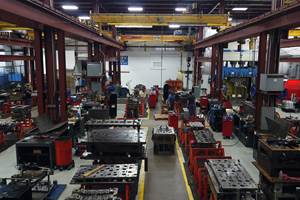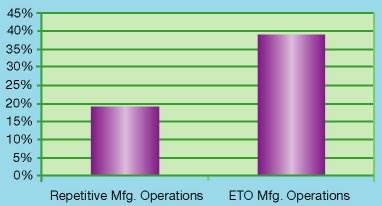Competing Against Time
A new ERP system helps a moldmaker to make job tracking 40 percent faster and deliveries 99 percent on time.
Shortening the time between customer order and delivery of parts defines manufacturing success in today's economy. Reducing leadtime, sharing information across the enterprise to support better, faster decision making, and delivering on time are key factors that keep customer relationships strong.
To stay on track, the help of a fully integrated ERP system is a fact of life in today's time-obsessed economy. When Jeff Johnson, CEO of two companies - F & G Multi-Slider (Franklin, OH) and F & G Tool and Die (Dayton, OH) - searched for a new ERP system for both enterprises two years ago, he had some stiff requirements. Almost every one of them involved time.
Back in 1998, the situation at both shops was troublesome. F & G Tool and Die worked manually. F & G Multi-Slider was automated, but its business management system was slow and cumbersome. Despite big differences in the way they operated, Johnson believed that both businesses needed a reasonably priced, off-the-shelf system that could provide customized reports, shorten time spent ordering materials, improve customer service and increase on-time deliveries.
In the end, Johnson's insistence on custom reports helped him decide on JobBOSS by Kewill ERP (Minneapolis, MN). "Our tool and die business does $8 million in sales annually. It's a 50-person company specializing in the design and building of progressive dies, transfer dies, fixtures and gauges for every industry - aerospace, automotive and electronics," says Johnson. "When we looked for a system, we needed specialized reports for our industry. But every place we went, we were going to have to pay big bucks to have reports done. With JobBOSS, my software manager was able to make any report necessary for us and for Multi-slider."
Two Different Companies - One Fast System
At first, management at F & G Multi-slider believed the system Johnson had chosen for the tool and die business would be inadequate. F & G Multi-slider is one of the few multi-slide shops in the country. Last year, the 45-person shop generated $8 million in business volume. Unlike the tool and die business, Multi-slider concentrates on metal stampings for the automotive, electronics and appliance industries, and required a system that could handle blanket orders, long running jobs and specialized work centers.
"The difference between conventional vertical presses and multi-slide presses is that we stand our parts up on their edges," says Dick Smith, Multi-slider's plant supervisor. "We go in and out the other way. We have die space and four slides coming in four different directions for forming and for more complex bending. Adjustments can be made independent of each other and won't affect other hits."
The customer base is different too. While F & G Tool and Die handles any job that comes its way, Multi-slider focuses on second tier automotive business - high-precision springs, brackets and other parts requiring complex bending and forming.
As the implementation progressed, Multi-slider began to see potential benefits. Now, two years later, both businesses run on JobBOSS separately, and both have benefited in different ways.
Improved Job Tracking
Thanks to better, more easily accessible data, Johnson now sees a savings in time spent on job tracking and accounting at F & G Tool and Die. Much of that efficiency is due to JobBOSS custom reports.
"We've saved about 40 percent in the job tracking and accounting time at F & G Tool and Die," says Johnson. "We've probably created 30 different reports for ourselves. They make it a lot easier to track our work. And with JobBOSS' Access Database, both businesses can write their own reports."
For example, Tool and Die's In Process Report tracks work flow. It labels and lists every job in the shop and gives the percentage of completion. "It's a spread sheet 10 to 12 pages long - sometimes 30 pages depending on our workload - with about 10 to 12 jobs per page," says Johnson. "This report gives us the job number, customer and job description. It lists quoted hours, hours applied to the job, and from that, percentage of completion of the job."
With so many different design and production jobs coming in and out, F & G's tool and die business uses the JobBOSS Data Collection module to stay abreast of what's happening on an hourly basis. Accounting needs to be tightly integrated with production, so invoices are generated automatically with each shipment of parts. Both tracking and accounting have sped up dramatically since the system was implemented in 1998.
Cutting Leadtimes
Nevertheless, the return on investment in the new system wasn't immediate at either shop. "It took about a year before we could get enough information into the system to start trusting the numbers," says Johnson. "The old way we costed was a lot different from the way JobBOSS costed."
But once the efficiencies kicked in, F & G Tool and Die found that it could track 100 to 300 jobs in process at one time - many of them multiple release jobs. The system also cut leadtimes by moving a job right into production. "The estimate gets copied over to a job in a matter of 15 to 20 seconds," notes Johnson. "Then we start ordering the steel and put the job in process."
The same is true at Multi-slider. Though its foreman enters more information up front than he used to, he likes the ease of transferring a quote to a job. "Once you quote a job, if you get it, all your work is done," says Dick Smith. "Everything is just a matter of copying a quote into a job. All the information is already there. It really streamlines the process."
A Snapshot of the Business
Unlike Tool and Die, F & G Multi-slider's business is based on long-term relationships with customers in the automotive industry. Their work levels rise and fall with the economy, and jobs last three, four, even 12 years - until a model of car is changed or discontinued.
"What we're doing today will be in production a year from now [at Ford, Chrysler, GM]," notes Smith. "We have jobs that stay in the presses all the time. We send out 80,000 pieces a week, 30 million pieces a year. I'd say 90 percent of our work is blanket orders - half a million to three million pieces per job all year long."
With so many jobs in process and such long-term, high-volume work, costing could get out of control. But Smith uses system data to keep an eye on every job, make timely changes and ensure profitability. "What I like about the system is that I'm able to follow my work from beginning to end and look at costing on a daily basis. Costing out jobs was difficult with our previous system, but now I have a snapshot on a job anytime. It's made us more profitable."
On-Time Delivery
A related benefit of the system at Multi-slider has been an increase in on-time deliveries. Job tracking, custom reports and improved ordering of material have given Smith and his team visibility of jobs and forecasting ability. Smith now works three months ahead, factoring in leadtimes with material and outside processing. "JobBOSS has been a factor in improving our on-time deliveries - from somewhere in the 80 percent range in the past to 99 percent now," says Smith. "We're able to watch how a product goes through the shop, track it, and the reports I get allow me to look out into the future any length of time."
On-time deliveries depend on timely delivery of materials, and the system's inventory tracking has been an asset. "Our material is specialized - all types of low carbon steel all the way up to the non-ferrous and stainless high carbon steel," says Smith. "Before, we'd order material, bring it in and perhaps not need it for four to six weeks. Now that we're better at tracking jobs, we bring in material on a Friday and it goes into the press on Monday or Tuesday. The shop no longer gets stuck with material that we've held on the floor four to six months, then decide we can't use."
Saving Time
At F & G Tool and Die, employees use JobBOSS to help reduce cycle time. Engineers design in AutoCAD, then transfer their AutoCAD stock sheet into an Access spreadsheet, then into JobBOSS, eliminating the purchasing agent's need to re-enter the different type steel sizes.
Tool and Die also uses the system to analyze performance. "Let's say we run a 100,000 piece order in five different lots," says Johnson. "We can get our costs from each lot. If employee A ran the first 20,000, and employee B ran the second lot, we can compare numbers and see who is doing a better job."
Overall, Johnson rates the system highly for both companies. The only downside, he admits, is the need to periodically invest in faster hardware to keep up with technological advances in the system.
Johnson believes that JobBOSS delivers at both sites: a tool and die shop that emphasizes its design and engineering capabilities and fast turn around and a highly specialized multi-slide shop meeting the quality and delivery demands of the auto industry. "The goal was to streamline," says Johnson. "We need to get jobs in and out the door as quickly as possible, and that's happening at both businesses."
Related Content
Take Time to Save Time: 6 Steps in Mold Design to Reduce Back-End Troubleshooting
Westminster Tool shares how the one week it typically takes to perform these six steps in the design phase can save three weeks or more in an overall tool build.
Read MoreIndiana Mold Builder Decatur Mold Offers a History of Grit and a Future of Innovation
Decatur Mold Tool and Engineering Inc. serves as a tooling tour guide, helping busy tooling managers reduce uncertainty, lighten workload.
Read MoreTolerancing in Mold Design, Part 2: Using GD&T to Address Conventional Tolerancing Issues
Mold designers can achieve a single interpretation of workpiece functionality when following the American Society of Mechanical Engineers Geometric Dimensioning and Tolerancing standard.
Read MoreWhat is Scientific Maintenance? Part 2
Part two of this three-part series explains specific data that toolrooms must collect, analyze and use to truly advance to a scientific maintenance culture where you can measure real data and drive decisions.
Read MoreRead Next
Can the Wrong ERP System Cost You Your Job?
More than one-third of all moldmaking manufacturers are custom shops, producing one-of-a-kind, unique products. Ironically, these special engineer-to-order manufacturers are the most vulnerable.
Read MoreReasons to Use Fiber Lasers for Mold Cleaning
Fiber lasers offer a simplicity, speed, control and portability, minimizing mold cleaning risks.
Read MoreHow to Use Strategic Planning Tools, Data to Manage the Human Side of Business
Q&A with Marion Wells, MMT EAB member and founder of Human Asset Management.
Read More







.jpg;maxWidth=300;quality=90)













